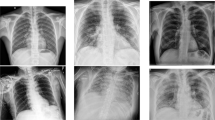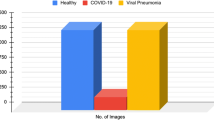Abstract
The new coronavirus pandemic has brought disruption to the world. The lack of mass testing for the population is among the significant dilemmas to be solved by countries, especially underdeveloped ones. An alternative to deal with the lack of tests is detecting the disease by analyzing radiographic images. To process different types of images automatically, we employed deep learning algorithms to achieve success in recognizing different diagnostics. This work aims to train a deep learning model capable of automatically recognizing the COVID-19 diagnosis through radiographic images. Comparing images of coronavirus, healthy lung, and bacterial and viral pneumonia, we obtained a result with 93% accuracy.








Similar content being viewed by others
Notes
References
Abbas A, Abdelsamea MM, Gaber MM. Classification of covid-19 in chest x-ray images using detrac deep convolutional neural network. 2020. arXiv:2003.13815.
Aishwarya T, Ravi Kumar V. Machine learning and deep learning approaches to analyze and detect covid-19: a review. SN Comput Sci. 2021;2(3):1–9.
Alom MZ, Rahman M, Nasrin MS, et al. Covid_mtnet: Covid-19 detection with multi-task deep learning approaches. 2020. arXiv:2004.03747.
Altan A, Karasu S. Recognition of covid-19 disease from x-ray images by hybrid model consisting of 2d curvelet transform, chaotic salp swarm algorithm and deep learning technique. Chaos Solitons Fractals. 2020;140(110):071.
Amyar A, Modzelewski R, Li H, et al. Multi-task deep learning based ct imaging analysis for covid-19 pneumonia: classification and segmentation. Comput Biol Med. 2020;126(104):037.
Apostolopoulos ID, Mpesiana TA. Covid-19: automatic detection from x-ray images utilizing transfer learning with convolutional neural networks. Phys Eng Sci Med. 2020;43(2):635–40.
Bai HX, Hsieh B, Xiong Z, et al. Performance of radiologists in differentiating covid-19 from viral pneumonia on chest ct. Radiology. 2020;296(2):E46-54.
Bello I, Zoph B, Vaswani A, et al. Attention augmented convolutional networks. In: Proceedings of the IEEE/CVF international conference on computer vision. 2019; p. 3286–95.
Bernstein AV, Burnaev E, Kachan ON. Reinforcement learning for computer vision and robot navigation. In: International conference on machine learning and data mining in pattern recognition. Springer; 2018. p. 258–72.
Canziani A, Paszke A, Culurciello E. An analysis of deep neural network models for practical applications. 2016. arXiv:1605.07678.
Chassagnon G, Vakalopoulou M, Battistella E, et al. Ai-driven quantification, staging and outcome prediction of covid-19 pneumonia. Med Image Anal. 2021;67(101):860.
Chen H. Machine learning for information retrieval: neural networks, symbolic learning, and genetic algorithms. J Am Soc Inf Sci. 1995;46(3):194–216.
Chieregato M, Frangiamore F, Morassi M, et al. A hybrid machine learning/deep learning covid-19 severity predictive model from ct images and clinical data. Sci Rep. 2022;12(1):1–15.
Cohen JP, Dao L, Morrison P, et al. Predicting covid-19 pneumonia severity on chest x-ray with deep learning. Cureus. 2020.
Coşkun M, Uçar A, Yildirim Ö, et al. Face recognition based on convolutional neural network. In: 2017 international conference on modern electrical and energy systems (MEES). IEEE; 2017. p. 376–379.
Cui S, et al. Fish detection using deep learning. Appl Comput Intell Soft Comput. 2020. https://doi.org/10.1155/2020/3738108.
Da Silva FL, Costa AHR. A survey on transfer learning for multiagent reinforcement learning systems. J Artif Intell Res. 2019;64:645–703.
de Oliveira RPdC, Sganderla GR, Maurício CRM, et al. Classificaçao de imagens de raio-x de torax com reconhecimento visual da ibm cloud para diagnostico de pneumonia. In: Anais Estendidos da XXXII Conference on graphics, patterns and images, SBC. 2019. p. 203–6.
de Sousa OL, Magalhães DM, Vieira PdA, et al. Deep learning in image analysis for covid-19 diagnosis: a survey. IEEE Latin Am Trans. 2020;100(1e).
dos Santos YCP, Estabelecidas C, Do Norte J. Desafios e impacto da inteligência artificial na medicina. 2017.
Duarte KTN, Gobbi DG, Frayne R, et al. Detecting Alzheimer’s disease based on structural region analysis using a 3d shape descriptor. In: 2020 33rd SIBGRAPI conference on graphics, patterns and images (SIBGRAPI). 2020. p. 180–87. https://doi.org/10.1109/SIBGRAPI51738.2020.00032.
Gorbalenya AE, Baker SC, Baric RS, et al. Coronaviridae study group of the international committee on taxonomy of viruses. The species severe acute respiratory syndrome-related coronavirus: classifying 2019-ncov and naming it sars-cov-2. Nat Microbiol. 2020;5(4):536–44.
Hamet P, Tremblay J. Artificial intelligence in medicine. Metabolism. 2017;69:S36–40.
Hu S, Gao Y, Niu Z, et al. Weakly supervised deep learning for covid-19 infection detection and classification from ct images. IEEE Access. 2020;8:118869–83.
Hu T, Khishe M, Mohammadi M, et al. Real-time covid-19 diagnosis from x-ray images using deep cnn and extreme learning machines stabilized by chimp optimization algorithm. Biomed Signal Process Control. 2021;68(102):764.
Islam MM, Karray F, Alhajj R, et al. A review on deep learning techniques for the diagnosis of novel coronavirus (covid-19). IEEE Access. 2021;9:30,551-30,572. https://doi.org/10.1109/ACCESS.2021.3058537.
Kim M, Kang J, Kim D, et al. Hi-covidnet: Deep learning approach to predict inbound covid-19 patients and case study in South Korea. In: Proceedings of the 26th ACM SIGKDD international conference on knowledge discovery & data mining. association for computing machinery, New York, KDD ’20. 2020. p 3466–73. https://doi.org/10.1145/3394486.3412864.
Ko H, Chung H, Kang WS, et al. Covid-19 pneumonia diagnosis using a simple 2d deep learning framework with a single chest ct image: model development and validation. J Med Internet Res. 2020;22(6):e19,569.
Kopiler AA, et al. Redes neurais artificiais e suas aplicações no setor elétrico. Revista de Engenharias da Faculdade Salesiana. 2019;9:27–33.
Lau SLH, Wang X, Yang X, et al. Automated pavement crack segmentation using fully convolutional u-net with a pretrained resnet-34 encoder. IEEE Access. 2020.
Lei L, Zhu H, Gong Y, et al. A deep residual networks classification algorithm of fetal heart ct images. In: 2018 IEEE international conference on imaging systems and techniques (IST). IEEE. 2018. p. 1–4.
Li L, Qin L, Xu Z, et al. Artificial intelligence distinguishes covid-19 from community acquired pneumonia on chest ct. Radiology. 2020.
Li S, Song W, Fang L, et al. Deep learning for hyperspectral image classification: an overview. IEEE Trans Geosci Remote Sens. 2019;57(9):6690–709.
Lopez-Rincon A, Tonda A, Mendoza-Maldonado L, et al. Classification and specific primer design for accurate detection of sars-cov-2 using deep learning. Sci Rep. 2021;11(1):1–11.
MAlnajjar MK, Abu-Naser SS. Heart sounds analysis and classification for cardiovascular diseases diagnosis using deep learning. IJARW. 2022.
Negreiros RRB, dos Santos RA, Alves ALF, et al. Oil identification on beaches using deep learning techniques. In: Anais Estendidos do XXXIII conference on graphics, patterns and images, SBC. 2020. p. 167–70.
Ohri K, Kumar M. Review on self-supervised image recognition using deep neural networks. Knowl-Based Syst. 2021;224(107):090.
Osóio FS, Bittencourt JR. Sistemas inteligentes baseados em redes neurais artificiais aplicados ao processamento de imagens. In: I Workshop de inteligência artificial. 2000.
Ouyang W, Zeng X, Wang X, et al. Deepid-net: object detection with deformable part based convolutional neural networks. IEEE Trans Pattern Anal Mach Intell. 2016;39(7):1320–34.
Phankokkruad M. Covid-19 pneumonia detection in chest x-ray images using transfer learning of convolutional neural networks. In: Proc. of the 3rd Intl. conf. on data science and information technology. Association for Computing Machinery, New York, DSIT 2020. 2020. p. 147–52.
Rajaraman S, Siegelman J, Alderson PO, et al. Iteratively pruned deep learning ensembles for covid-19 detection in chest x-rays. IEEE Access. 2020.
Rashed EA, Hirata A. Infectivity upsurge by covid-19 viral variants in Japan: evidence from deep learning modeling. Int J Environ Res Public Health. 2021;18(15):7799.
Rodrigues JCL, et al. Performance of radiologists in differentiating covid-19 from viral pneumonia on chest ct. Public Health Emerg Collect. 2020. https://doi.org/10.1016/j.crad.2020.03.003.
Shi F, Wang J, et al. Review of artificial intelligence techniques in imaging data acquisition, segmentation and diagnosis for covid-19. IEEE Rev Biomed Eng. 2020.
Shiaelis N, Tometzki A, Peto L, et al. Virus detection and identification in minutes using single-particle imaging and deep learning. MedRxiv. 2022. p. 2020–10.
Shorten C, Khoshgoftaar TM, Furht B. Deep learning applications for covid-19. J Big Data. 2021;8(1):1–54.
Silva I, Leoni G, Sadok D, et al. Classifying covid-19 positive x-ray using deep learning models. IEEE Lat Am Trans. 2021;19:884–92. https://doi.org/10.1109/TLA.2021.9451232.
Silva. I, Negreiros. R, Alves. A, et al. Classification of chest x-ray images to diagnose covid-19 using deep learning techniques. In: Proceedings of the 19th international conference on wireless networks and mobile systems—WINSYS,, INSTICC. SciTePress; 2022. p. 93–100. https://doi.org/10.5220/0011339700003286.
Singh S, Ahuja U, Kumar M, et al. Face mask detection using yolov3 and faster r-cnn models: Covid-19 environment. Multimed Tools Appl. 2021;80(13):19,753-19,768.
Spörl C, Castro E, Luchiari A. Aplicação de redes neurais artificiais na construção de modelos de fragilidade ambiental. Revista do Departamento de Geografia. 2011;21:113–35.
Topol EJ. Welcoming new guidelines for ai clinical research. Nat Med. 2020;26(9):1318–20.
Voulodimos A, Doulamis N, Doulamis A, et al. (2018) Deep learning for computer vision: a brief review. Comput Intell Neurosci. 2018;7068:349.
Wong HYF, Lam HYS, Fong AH, et al. Frequency and distribution of chest radiographic findings in patients positive for covid-19. Radiology. 2020. https://doi.org/10.1148/radiol.2020201160.
Wu X, Hui H, Niu M, et al. Deep learning-based multi-view fusion model for screening 2019 novel coronavirus pneumonia: a multicentre study. Eur J Radiol. 2020;128(109):041.
Wynants L, Van Calster B, Collins GS, et al. Prediction models for diagnosis and prognosis of covid-19: systematic review and critical appraisal. BMJ. 2020;369.
Zhao ZQ, Zheng P, St Xu, et al. Object detection with deep learning: a review. IEEE Trans Neural Netw Learn Syst. 2019;30(11):3212–32.
Zheng C, Deng X, Fu Q, et al. Deep learning-based detection for covid-19 from chest ct using weak label. IEEE Trans Med Imaging. 2020.
Zhu X, Goldberg AB. Introduction to semi-supervised learning. Synth Lect Artif Intell Mach Learn. 2009;3(1):1–130.
Author information
Authors and Affiliations
Corresponding author
Ethics declarations
Conflict of interest
Besides, the authors declare that there is no interest conflict.
Research involving human participants and/or animals
This article does not contain any studies with human participants or animals performed by any of the authors
Additional information
Publisher's Note
Springer Nature remains neutral with regard to jurisdictional claims in published maps and institutional affiliations.
This article is part of the topical collection “Wireless Networks and Mobile Systems” guest edited by Jaime Lloret Mauri and Joel Rodrigues.
Rights and permissions
Springer Nature or its licensor (e.g. a society or other partner) holds exclusive rights to this article under a publishing agreement with the author(s) or other rightsholder(s); author self-archiving of the accepted manuscript version of this article is solely governed by the terms of such publishing agreement and applicable law.
About this article
Cite this article
Negreiros, R.R.B., Silva, I.H.S., Alves, A.L.F. et al. COVID-19 Diagnosis Through Deep Learning Techniques and Chest X-Ray Images. SN COMPUT. SCI. 4, 613 (2023). https://doi.org/10.1007/s42979-023-02043-1
Received:
Accepted:
Published:
DOI: https://doi.org/10.1007/s42979-023-02043-1




